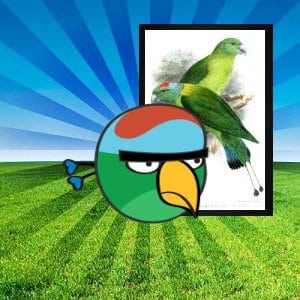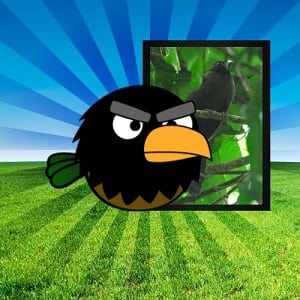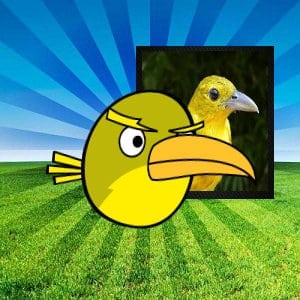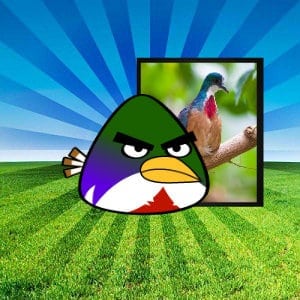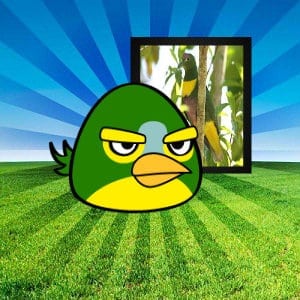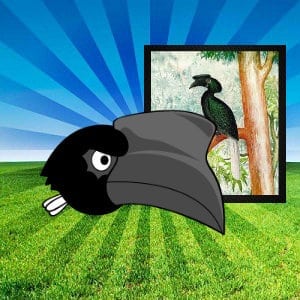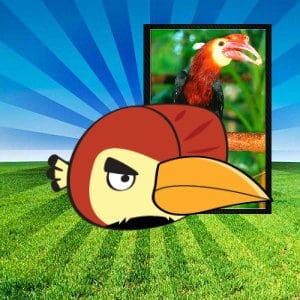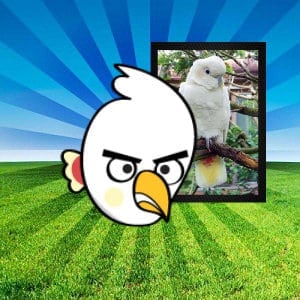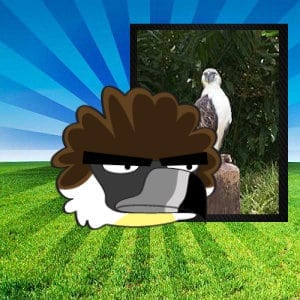Real-Life Angry Birds: 10 of the Most Endangered Birds in the Philippines

In the Philippines, 22 rare birds are now endangered. Out of these 22 , 13 endemic birds are deemed critically endangered.
International Union for Conservation of Nature (IUCN) has put these birds on the “critically endangered” list due to factors such as significant population reduction, a smaller area of occupancy, and 50% probability of extinction within the next 10 years.
Ten of these critically endangered birds are featured on this list. Designed by Fil-Am graphic artist Albert Balbutin Jr., these “angry birds”-inspired designs are for educational purposes only and in no way related to the popular mobile game.
READ: The Philippine Eagle (And Why It Should Not Be Called Monkey-eating)
10. Cebu Flowerpecker
Scientific name: Dicaeum quadricolor.
Bird profile: These birds have extremely low population and are endemic to the island of Cebu, Philippines. Male flowerpeckers (as shown above) are more common and bear unique physical characteristics such as a black head, grayish-white underparts, blackish-blue wings, red back and short, stout beak. Female birds basically lack scarlet-red back and feature brownish-grey underparts. On average, Cebu flowerpeckers can grow to as much as 11-12 centimeters long.
Interesting fact: No actual photo of a Cebu flowerpecker exists today. This can be blamed to the bird’s elusive nature and small size. In addition to that, Cebu flowerpecker had been considered extinct for almost 100 years until famed zoologist Rob Timmins rediscovered it in 1992.
It has been estimated that the remaining 85-105 individual birds are scattered in the villages of Tabunan, Nug-As, Dalaguete, and Mt. Lantoy. In 2009, Cebu flowerpecker was given the “Bird Life Species Champion” award and officially became the ‘flagship species’ of the British Birdwatching Fair 2009.
9. Sulu Racquet Tail
Scientific name: Prioniturus verticalis.
Bird profile: Also known as Lorito-momoto De Las Sulu, these green parrots inhabit tropical lowland and mangrove forests of Sulu. They can also be found in Tawi-Tawi although continuous deforestation has brought their numbers to an all-time low. Recent observations reveal that there might be only 250 mature individuals remaining today. A typical Sulu racquet tail has a grey-white bill, racquet-like tail extensions, bright green head, and a blue crown that has a unique red center spot in males.
Interesting fact: Prioniturus verticalis are tame parrots easily recognizable due to their tails. They have two long, blackish tail extensions that feature a racquet-like shape on its end, hence the name. These critically-endangered birds are commonly confused with the Tanygnathus parrots which have shorter tails, pale bills, and racquets that are less conspicuous.
8. Black Hooded Coucal
Scientific name: Centropus steerii.
Bird profile: Black-hooded coucal is a species of cuckoo in the Cuculidae family. Mature individuals are usually 46 centimeters long and prefer to inhabit subtropical or tropical moist lowland forests. They have a dark bill, greenish-black tail, brownish feathers, and a black head forming a hood. These birds are endemic to Mindoro but since 1980, sightings have been limited to only three localities namely Puerto Galera, Malpalon, and Siburan.
Interesting fact: Centropus steerii are forest-dwelling birds that usually stay in vine-tangles and thick canopy. Their voice is characterized by “five to eight woop notes given in a descending manner”.
7. Isabela Oriole
Scientific name: Oriolus isabellae.
Bird profile: Isabela oriole is a medium-sized bird endemic to the Bataan Peninsula and Isabela province in Luzon. The last known record of this species dates as far back as 1961. Today, an estimated 75-374 are said to exist in three different localities of Bataan. They are usually 20 centimeters in length, have an olive-green head, reddish eyes, dark grey legs, large grey bill, olive-brown wings, and yellowish underparts.
Interesting fact: Isabela oriole is frequently seen in thick bamboo forests or forest edge that has a height of 50-440 m.
6. Negros Bleeding Heart
Scientific name: Gallicolumba keayi.
Bird profile: Negros bleeding heart is a ground-dwelling pigeon that is endemic to the islands of Panay and Negros. It is popular for the bright red patch at the center of its white breast and throat. They have a dark green crown, nape and upper breast sides. The upper parts have dark chestnut color while their wings are reddish-purple with a grey band.
The number of Negros bleeding heart pigeons started to dwindle in the 1930s due to extensive forest loss. It has been estimated that only 75-374 individuals remain in Negros today.
Interesting fact: Negros bleeding heart is a ground-feeder that can fly in short distances or make territorial calls when threatened. It is different from Emerald dove or white-eared brown dove by virtue of its “soft coo and a high-pitched uu-oom.”
5. Negros Fruit Dove
Scientific name: Ptilinopus arcanus.
Bird profile: Negros fruit dove is an extremely rare species of bird from the pigeon and dove family of Columbidae. In 1953, the only known female specimen of this bird was collected from Mount Kanlaon in the northern part of the Negros island. The specimen shows that Negros fruit dove is very small (about 16.5 cm.) and features an extensive yellow eye-ring. It also has an ashy-grey forehead, white throat, and yellow undertails.
Interesting fact: No evidence has been retrieved yet to fully describe this bird’s behavior. Its rarity, though, could be due to extensive forest loss which might have pushed the surviving species to leave the lowland forests and transfer to higher elevations. Recent estimates suggest that only 50 mature individuals might still exist.
4. Sulu Hornbill
Scientific name: Anthracoceros montani.
Bird profile: With an estimated population of only 20 pairs, Sulu Hornbill is one of the rare Philippine birds that now face imminent extinction. It is endemic to the three islands of Sulu archipelago namely Jolo, Tawi-Tawi, and Sanga Sanga. These birds feature a black casque and bill, white long tail, blackish skin, and dark green upperparts.
Interesting fact: Anthracoceros montani is known to utter a series of “loud cackling and shrieking calls.” Due to forest clearing, they now live on mountain slopes and occasionally visit fruit trees that are at least 1 kilometer from the nearest forest.
3. Visayan Wrinkled Hornbill
Scientific name: Aceros waldeni.
Bird profile: Also known as Rufous-headed Hornbill, this forest-dwelling bird from Panay got its name from the wrinkled bony crest above its bill known as casque. Male hornbills have characteristically reddish-brown head, neck, and upper breast. Its upper parts feature a glossy green color while the rest of its feathers are blackish.
Fruit-bearing trees are their natural habitat, destruction of which have decreased their population tremendously. Visayan wrinkled hornbills also have very slow reproduction cycle which, combined with habitat loss, have eventually put them on the list of critically endangered birds.
Interesting fact: Visayan wrinkled hornbills live in small and noisy groups. They also have a unique ability to apply a “makeup” on their bills. They do this with the help of a gland at the base of their tails which they stimulate to apply orange or red-yellow stains on their bills.
2. Philippine Cockatoo
Scientific name: Cacatua haematuropygia.
Bird profile: Philippine cockatoo is a small, majestic white bird endemic to Palawan and several Visayan provinces where it is known by its local name katala. Adults have an erectile crest, pinkish ear-coverts, and red undertail. They also have deep yellow suffusion beneath the wings and tail.
Due to extensive lowland habitat loss and rampant trapping for the pet trade, Philippine cockatoo has been classified as critically endangered by the IUCN. In connection with this, plans of opening a coal-fired powered plant near Rasa Island in Palawan have been strongly opposed by conservationists. Rasa Island is a sanctuary that currently keeps 260 of the 1,000 remaining red-vented cockatoos in the world.
Interesting fact: Philippine cockatoos are usually found in lowland or mangrove forests. They occasionally fly on the forest edge and high mountainsides to search for food. Outside breeding seasons, Philippine cockatoos are often seen in flocks as they hunt for crops such as corn.
1. Philippine Eagle
Scientific name: Pithecophaga jefferyi.
Bird profile: This 3-foot giant raptor, also known as the country’s national bird, is world-famous for its lion-like crest and a broad wingspan of 7 feet.
It is sometimes referred to as monkey-eating eagle because it feeds on small primates. Philippine eagle also eats hornbills, snakes, wild cats, and flying lemurs. It has a large bill, white underparts, elongated nape feathers, dark face, and creamy-buff crown.
These huge birds often hide in the lowland forests of Luzon, Leyte, Samar, and Mindanao. But due to rampant deforestation, it is estimated that only 400 pairs of them exist today, some of which are held captive at the Philippine Eagle Foundation in Mount Apo.
Interesting fact: Philippine eagles are one of the most responsible parents in the avian world. They listen and respond to the cries of their hatchlings who are dependent on their parents for several months. They build their nests on the highest parts of the forest trees, approximately 30 meters off the ground.
Also Read: Top 10 Weird Animals You Won’t Believe Are in the Philippines
FilipiKnow
FilipiKnow strives to ensure each article published on this website is as accurate and reliable as possible. We invite you, our reader, to take part in our mission to provide free, high-quality information for every Juan. If you think this article needs improvement, or if you have suggestions on how we can better achieve our goals, let us know by sending a message to admin at filipiknow dot net
Copyright Notice
All materials contained on this site are protected by the Republic of the Philippines copyright law and may not be reproduced, distributed, transmitted, displayed, published, or broadcast without the prior written permission of filipiknow.net or in the case of third party materials, the owner of that content. You may not alter or remove any trademark, copyright, or other notice from copies of the content. Be warned that we have already reported and helped terminate several websites and YouTube channels for blatantly stealing our content. If you wish to use filipiknow.net content for commercial purposes, such as for content syndication, etc., please contact us at legal(at)filipiknow(dot)net

